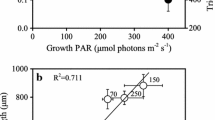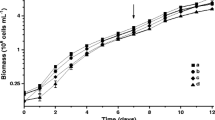Abstract
The influence of pH 3–10 on the growth, motility and photosynthesis inEuglena gracilis was demonstrated during a 7-d cultivation. The cells did not survive at pH<4 and >8, highest growth rate being detected at pH 7. Motility followed a similar patterns as growth rate. Photosynthetic response curves were shown to be of the same type over the whole pH range. High respiration was characteristic for cells grown at pH 5 and 6, the lowest one at 7. At high and also at low pH more active respiration was found which can be considered as a protective response on proton stress. Respiration was not completely inhibited with potassium cyanide. Photosynthesis was the most effective at pH 6; lower and higher pH decreased photosynthetic efficiency. pH affected more the growth rate than the photosynthesis.
Similar content being viewed by others
References
Agrawal S.C., Singh V.: Vegetative survival, akinete formation and germination in three blue-green algae and one green alga in relation to light intensity, temperature, heat shock and UV exposure.Folia Microbiol.45, 439–446 (2000).
Axelsson L., Mercado J.M., Figueroa F.L.: Utilization of HCO3− at high pH by the brown macroalgaLaminaria saccharina.Eur. J. Phycol.35, 53–59 (2000).
Backor M., Hudak J., Backorova M.: Comparison between growth responses of autotrophic and heterotrophic populations of lichen photobiontTrebouxia irregularis (Chlorophyta) on Cu, Hg and Cd chlorides treatment.Phytol. Ann.-Rei. Bot.38, 239–250 (1998).
Bannister T.: A general theory of steady state phytoplankton growth in a nutrient saturated mixed layer.Limnol. Oceanogr.19, 13–30 (1974).
Buetow D.E.: The mitochondrion, pp. 247–314 in D.E. Buetow (Ed.):The Biology of Euglena. Academic Press, New York 1989.
Campbell P.G.C., Stokes P.M.: Acidification and toxicity of metals to aquatic biota.Can. J. Fish Aquat. Sci.42, 2034–2049 (1985).
Checcucci A., Colombetti G., Ferrara R., Lenci F.: Action spectra for photoaccumulation of green and colorlessEuglena: evidence for identification of receptor pigments.Photochem. Photobiol.23, 51–54 (1976).
Chen C.Y., Durbin E.G.: Effect of pH on the growth and carbon uptake of marine phytoplankton.Mar. Ecol. Progr. Ser.109, 83–94 (1994).
Danilov R.A., Ekelund N.G.A.: Influence of waste water from the paper industry and UV-B radiation on the photosynthetic efficiency ofEuglena gracilis.J. Appl. Phycol.11, 157–163 (1999).
Danilov R.A., Ekelund N.G.A.: Effects of increasing doses of UV-B radiation on photosynthesis and motility inChlamydomonas reinhardtii.Folia Microbiol.45, 41–44 (2000).
Franklin N.M., Stauber J.L., Markich S.J., Lim R.P.: pH-dependent toxicity of copper and uranium to a tropical freshwater alga (Chlorella sp.).Aquat. Toxicol.48, 275–289 (2000).
Genter R.B., Amyot D.J.: Fresh-water benthic algal population and community changes due to acidity and aluminium-acid mixtures in artificial streams.Environ. Toxicol. Chem.13, 369–380 (1994).
Granbom M., Pedersen M.: Carbon acquisition strategies of the red algaEucheuma denticulatum.Hydrobiologia399, 349–354 (1999).
Häder D.-P., Lebert M., Tahedl H., Richter P.: The Erlanger flagellate test (EFT): photosynthetic flagellates in biological dosimeters.J. Photochem. Photobiol.40, 23–28 (1997).
Herrmann J., Degerman E., Gerhardt A., Johansson C., Lingdell P.-E., Muniz I.P.: Acid-stress effects on stream biologAmbio22, 298–307 (1993).
Israel A., Katz S., Dubinsky Z., Merrill J.E., Friedlander M.: Photosynthetic inorganic carbon utilization and growth ofPorphyra linearis (Rhodophyta).J. Appl. Phycol.11, 447–453 (1999).
Kapfer M.: Assessment of the colonization and primary production of microphytobenthos in the littoral of acidic mining lakes in Lusatia (Germany).Water Air Soil Pollut.108, 331–340 (1998).
Korneva L.G.: Impact of acidification on structural organization of phytoplankton community in the forest lakes of the North-Western Russia.Water Sci. Tech.33, 291–296 (1996).
Larsson C., Axelsson L.: Bicarbonate uptake and utilization in marine macroalgae.Eur. J. Phycol.34, 79–86 (1999).
Mayo A.W.: Effects of temperature and pH on the kinetic growth of unialgaChlorella vulgaris cultures containing bacteria.Water Environ. Res.69, 64–72 (1997).
Mercado J.M., Niell F.X., Figueroa F.L.: Regulation of mechanism for HCO3− use by the inorganic carbon level inPorphyra leucosticaThur inLe Jolis (Rhodophyta).Planta201, 319–325 (1997).
Nalewajko C., Colman B., Olaveson M.: Effects of pH on growth, photosynthesis, respiration, and copper tolerance of threeScenedesmus strains.Environ. Exp. Bot.37, 153–160 (1997).
Nilsson A.N., Johansson A.: A comparative study of the benthos of limed and not-limed streams: effects of different liming methods.Inform. Inst. Freshw. Res. (Drottningholm)11, 1–56 (1985).
Ögren E., Evans J.R.: Photosynthetic light-response curves.Planta189, 182–190 (1993).
Peterson H.G., Healey F.P., Wagemann R.: Metal toxicity to algae: a highly pH dependent phenomenon.Can. J. Fish Aquat Sci.41, 974–979 (1984).
Platt T., Jassby A.: The relationship between photosynthesis and light for natural assemblages of coastal marine phytoplankton.J. Phycol.12, 421–430 (1976).
Porst M., Lebert M., Häder D.-P.: Long-term cultivation of the flagellateEuglena gracilis.Micrograv. Sci. Technol.10, 166–169 (1997).
Poskuta J.W., Parys E., Romanowska E.: Toxicity of lead to photosynthesis, accumulation of chlorophyll, respiration and growth ofChlorella pyrenoidosa. Protective role of dark respiration.Acta Physiol. Plant.18, 165–171 (1996).
Raven J.A.: Putting the C in phycology.Eur. J. Phycol.32, 319–333 (1997).
Tubak S., Olson S., McFeters G.: Comparison of algae assay systems for detecting waterborne herbicides and metals.Water Res.20, 91–96 (1986).
Twist H., Edwards A.C., Codd G.A.: Algal growth responses to waters of contrasting tributaries of the river Dee, North-East Scotland.Water Res.32, 2471–2479 (1998).
Visviki I., Santikul D.: The pH tolerance ofChlamydomonas applanata (Volvocales, Chlorophyta).Arch. Environ. Contam. Toxicol.38, 147–151 (2000).
Author information
Authors and Affiliations
Corresponding author
Rights and permissions
About this article
Cite this article
Danilov, R.A., Ekelund, N.G.A. Effects of pH on the growth rate, motility and photosynthesis inEuglena gracilis . Folia Microbiol 46, 549–554 (2001). https://doi.org/10.1007/BF02818001
Received:
Revised:
Issue Date:
DOI: https://doi.org/10.1007/BF02818001




